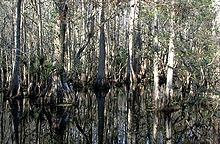| Revision as of 01:29, 29 October 2007 editAdam.J.W.C. (talk | contribs)Extended confirmed users, Pending changes reviewers21,298 editsm Reverted 1 edit by 142.166.157.4 identified as vandalism to last revision by Jlrsousa. using TW← Previous edit | Revision as of 15:47, 12 November 2007 edit undoEnternoted (talk | contribs)29 edits Removing picture of junk and rock pile with old rusted boat.Next edit → | ||
| Line 3: | Line 3: | ||
| {{otheruses4|wetland type (a landform)|other uses of the term "swamp"|Swamp (disambiguation)}} | {{otheruses4|wetland type (a landform)|other uses of the term "swamp"|Swamp (disambiguation)}} | ||
| ].]] | ].]] | ||
| ], ].]] | |||
| A '''swamp''' is a ] that features temporary or permanent inundation of large areas of land by shallow bodies of water, generally with a substantial number of ], or dry-land protrusions, and covered by aquatic vegetation, or vegetation that tolerates periodical inundation.<ref> (from glossary webpage of the ])</ref> The water of a swamp may be ] or ]. A swamp is also generally defined as having no substantial ] deposits.<ref> (from the glossary of the Environmental Health Center, ])</ref> | A '''swamp''' is a ] that features temporary or permanent inundation of large areas of land by shallow bodies of water, generally with a substantial number of ], or dry-land protrusions, and covered by aquatic vegetation, or vegetation that tolerates periodical inundation.<ref> (from glossary webpage of the ])</ref> The water of a swamp may be ] or ]. A swamp is also generally defined as having no substantial ] deposits.<ref> (from the glossary of the Environmental Health Center, ])</ref> | ||
Revision as of 15:47, 12 November 2007
| This article needs additional citations for verification. Please help improve this article by adding citations to reliable sources. Unsourced material may be challenged and removed. Find sources: "Swamp" – news · newspapers · books · scholar · JSTOR (October 2006) (Learn how and when to remove this message) |

A swamp is a wetland that features temporary or permanent inundation of large areas of land by shallow bodies of water, generally with a substantial number of hammocks, or dry-land protrusions, and covered by aquatic vegetation, or vegetation that tolerates periodical inundation. The water of a swamp may be fresh water or salt water. A swamp is also generally defined as having no substantial peat deposits.
In North America, swamps are usually regarded as including a large amount of woody vegetation, but elsewhere this may not necessarily apply, such as in African swamps dominated by papyrus. By contrast a marsh in North America is a wetland without woody vegetation, or elsewhere, a wetland without woody vegetation which is shallower and has less open water surface than a swamp. A mire (or quagmire) is a low-lying wetland of deep, soft soil or mud that sinks underfoot.
Geology
Swamps are generally characterised by very slow-moving waters. They are usually associated with adjacent rivers or lakes. In some cases, rivers become swamps for a distance. Swamps are features of areas with very low topographic relief, although they may be surrounded by mountains.
Ecology
Swamps are characterised by rich biodiversity and specialised organisms. For instance, southeastern U.S. swamps, such as those mentioned above, feature trees such as the Bald cypress and Water tupelo, which are adapted to growing in standing water, and animals such as the American alligator. A common species name in biological nomenclature is the Latin palustris, meaning "of the swamp". Examples of this are Quercus palustris (pin oak) and Thelypteris palustris (marsh fern).
Draining
Swamps were historically often drained to provide additional land for agriculture, and to reduce the threat of diseases born by swamp insects and similar animals. Swamps were generally seen as useless and even dangerous. This practice of swamp draining is nowadays seen as a destruction of a very valuable ecological habitat type of which large tracts have already disappeared in many countries.
Famous examples
In Iraq
The Tigris-Euphrates river system is a large swamp and river system in southern Iraq, inhabited in part by the Marsh Arabs. It was partly drained by Saddam Hussein in the 1990s in retaliation against the Shiite tribes' revolt against his dictatorship.

In the United States
The most famous swamps in the United States are the Everglades, Okefenokee Swamp and the Great Dismal Swamp. The Okefenokee is located in extreme southeastern Georgia and extends slightly into northeastern Florida. The Great Dismal Swamp lies in extreme southeastern Virginia and extreme northeastern North Carolina. Both are National Wildlife Refuges. Another swamp area, Reelfoot Lake of extreme western Tennessee, was created by the New Madrid earthquake of 1812. Caddo Lake, the Great Dismal and Reelfoot are swamps that are centered at large lakes. Swamps are often called bayous in the southeastern United States, especially in the Gulf Coast region.
Heraldry
A swamp appears in the coat of arms of Gesturi, Italy.
List of major swamps
Africa
Asia
North America
- Great Black Swamp, United States
- Great Dismal Swamp, United States
- Great Pocomoke Swamp also known as Great Cypress Swamp, Maryland, United States
- Okefenokee Swamp, Georgia/Florida, United States
- Reelfoot Lake, United States
- Big Cypress National Preserve, Florida, United States
- Limberlost, Indiana, United States
- Honey Island Swamp, Louisiana, United States
- Great Swamp National Wildlife Refuge, New Jersey, United States
- Atchafalaya National Wildlife Refuge, Louisiana, United States
South America
See also
References
- Swamp (from glossary webpage of the United States Geological Survey)
- Swamp (from the glossary of the Environmental Health Center, National Safety Council)